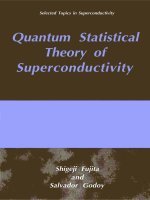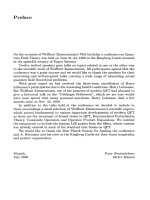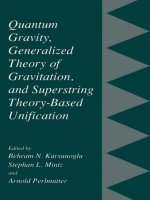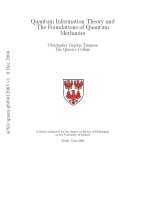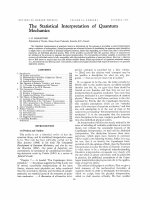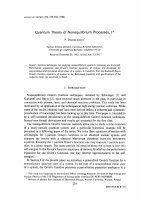- Trang chủ >>
- Khoa Học Tự Nhiên >>
- Vật lý
Quantum statistical theory of superconductivity
Bạn đang xem bản rút gọn của tài liệu. Xem và tải ngay bản đầy đủ của tài liệu tại đây (3.65 MB, 359 trang )
Quantum Statistical Theory
of Superconductivity
www.pdfgrip.com
SELECTED TOPICS IN SUPERCONDUCTIVITY
Series Editor:
Stuart Wolf
Naval Research Laboratory
Washington, D. C.
CASE STUDIES IN SUPERCONDUCTING MAGNETS
Design and Operational Issues
Yukikazu Iwasa
INTRODUCTION TO HIGH-TEMPERATURE SUPERCONDUCTIVITY
Thomas P. Sheahen
THE NEW SUPERCONDUCTORS
Frank J. Owens and Charles P. Poole, Jr.
QUANTUM STATISTICAL THEORY OF SUPERCONDUCTIVITY
Shigeji Fujita and Salvador Godoy
STABILITY OF SUPERCONDUCTORS
Lawrence Dresner
A Continuation Order Plan is available for this series. A continuation order will bring
delivery of each new volume immediately upon publication. Volumes are billed only upon
actual shipment. For further information please contact the publisher.
www.pdfgrip.com
Quantum Statistical Theory
of Superconductivity
Shigeji Fujita
SUNY, Buffalo
Buffalo, New York
and
Salvador Godoy
Universidad Nacional Autonoma de México
México, D. F., México
Kluwer Academic Publishers
NEW YORK, BOSTON , DORDRECHT, LONDON , MOSCOW
www.pdfgrip.com
eBook ISBN
0-306- 47068-3
Print ISBN
0-306-45363-0
©2002 Kluwer Academic Publishers
New York, Boston, Dordrecht, London, Moscow
All rights reserved
No part of this eBook may be reproduced or transmitted in any form or by any means, electronic,
mechanical, recording, or otherwise, without written consent from the Publisher
Created in the United States of America
Visit Kluwer Online at:
and Kluwer's eBookstore at:
www.pdfgrip.com
Preface to the Series
Since its discovery in 1911, superconductivity has been one of the most interesting topics
in physics. Superconductivity baffled some of the best minds of the 20th century and was
finally understood in a microscopic way in 1957 with the landmark Nobel Prize-winning
contribution from John Bardeen, Leon Cooper, and Robert Schrieffer. Since the early 1960s
there have been many applications of superconductivity including large magnets for medical
imaging and high-energy physics, radio-frequency cavities and components for a variety
of applications, and quantum interference devices for sensitive magnetometers and digital
circuits. These last devices are based on the Nobel Prize-winning (Brian) Josephson effect.
In 1987, a dream of many scientists was realized with the discovery of superconducting
compounds containing copper–oxygen layers that are superconducting above the boiling
point of liquid nitrogen. The revolutionary discovery of superconductivity in this class of
compounds (the cuprates) won Georg Bednorz and Alex Mueller the Nobel Prize.
This series on Selected Topics in Superconductivity will draw on the rich history of
both the science and technology of this field. In the next few years we will try to chronicle
the development of both the more traditional metallic superconductors as well as the
scientific and technological emergence of the cuprate superconductors. The series will
contain broad overviews of fundamental topics as well as some very highly focused treatises
designed for a specialized audience.
v
www.pdfgrip.com
This page intentionally left blank.
www.pdfgrip.com
Preface
Superconductivity is a striking physical phenomenon that has attracted the attention of
physicists, chemists, engineers, and also the nontechnical public. The theory of superconductivity is considered difficult. Lectures on the subject are normally given at the
end of Quantum Theory of Solids, a second-year graduate course.
In 1957 Bardeen, Cooper, and Schrieffer (BCS) published an epoch-making microscopic theory of superconductivity. Starting with a Hamiltonian containing electron
and hole kinetic energies and a phonon-exchange-pairing interaction Hamiltonian, they
demonstrated that (1) the ground-state energy of the BCS system is lower than that of
the Bloch system without the interaction, (2) the unpaired electron (quasi-electron) has
an energy gap ∆ 0 at 0 K, and (3) the critical temperature Tc can be related to ∆ 0 by
2 ∆ 0 = 3.53 k B Tc , and others. A great number of theoretical and experimental investigations followed, and results generally confirm and support the BCS theory. Yet a number
of puzzling questions remained, including why a ring supercurrent does not decay by
scattering due to impurities which must exist in any superconductor; why monovalent
metals like sodium are not superconductors; and why compound superconductors, including intermetallic, organic, and high-T c superconductors exhibit magnetic behaviors
different from those of elemental superconductors.
Recently the present authors extended the BCS theory by incorporating band structures of both electrons and phonons in a model Hamiltonian. By doing so we were able
to answer the preceding questions and others. We showed that under certain specific
conditions, elemental metals at low temperatures allow formation of Cooper pairs by the
phonon exchange attraction. These Cooper pairs, called the pairons, for short, move as
free bosons with a linear energy–momentum relation. They neither overlap in space nor
interact with each other. Systems of pairons undergo Bose–Einstein condensations in two
and three dimensions. The supercondensate in the ground state of the generalized BCS
system is made up of large and equal numbers of ± pairons having charges ±2e, and
it is electrically neutral. The ring supercurrent is generated by the ± pairons condensed
at a single momentum q n = 2π n L – 1 , where L is the ring length and n an integer. The
macroscopic supercurrent arises from the fact that ± pairons move with different speeds.
Josephson effects are manifestations of the fact that pairons do not interact with each
other and move like massless bosons just as photons do. Thus there is a close analogy
between a supercurrent and a laser. All superconductors, including high-T c cuprates, can
be treated in a unified manner, based on the generalized BCS Hamiltonian.
vii
www.pdfgrip.com
PREFACE
viii
Because the supercondensate can be described in terms of independently moving
pairons, all properties of a superconductor, including ground-state energy, critical temperature, quasi-particle energy spectra containing gaps, supercondensate density, specific
heat, and supercurrent density can be computed without mathematical complexities. This
simplicity is in great contrast to the far more complicated treatment required for the phase
transition in a ferromagnet or for the familiar vapor–liquid transition.
The authors believe that everything essential about superconductivity can be presented to beginning second-year graduate students. Some lecturers claim that much
physics can be learned without mathematical formulas, that excessive use of formulas
hinders learning and motivation and should therefore be avoided. Others argue that
learning physics requires a great deal of thinking and patience, and if mathematical
expressions can be of any help, they should be used with no apology. The average
physics student can learn more in this way. After all, learning the mathematics needed
for superconductor physics and following the calculational steps are easier than grasping
basic physical concepts. (The same cannot be said about learning the theory of phase
transitions in ferromagnets.) The authors subscribe to the latter philosophy and prefer
to develop theories from the ground up and to proceed step by step. This slower but
more fundamental approach, which has been well-received in the classroom, is followed
in the present text. Students are assumed to be familiar with basic differential, integral,
and vector calculuses, and partial differentiation at the sophomore–junior level. Knowledge of mechanics, electromagnetism, quantum mechanics, and statistical physics at the
junior–senior level are prerequisite.
A substantial part of the difficulty students face in learning the theory of superconductivity lies in the fact that they need not only a good background in many branches
of physics but must also be familiar with a number of advanced physical concepts such
as bosons, fermions, Fermi surface, electrons and holes, phonons, Debye frequency, and
density of states. To make all of the necessary concepts clear, we include five preparatory
chapters in the present text. The first three chapters review the free-electron model of a
metal, theory of lattice vibrations, and theory of the Bose–Einstein condensation. There
follow two additional preparatory chapters on Bloch electrons and second quantization
formalism. Chapters 7–11 treat the microscopic theory of superconductivity. All basic
thermodynamic properties of type I superconductors are described and discussed, and
all important formulas are derived without omitting steps. The ground state is treated
by closely following the original BCS theory. To treat quasi-particles including Bloch
electrons, quasi-electrons, and pairons, we use Heisenberg’s equation-of-motion method,
which reduces a quantum many-body problem to a one-body problem when the systemHamiltonian is a sum of single-particle Hamiltonians. No Green’s function techniques
are used, which makes the text elementary and readable. Type II compounds and high-Tc
superconductors are discussed in Chapters 12 and 13, respectively. A brief summary and
overview are given in the first and last chapters.
In a typical one-semester course for beginning second-year graduate students, the
authors began with Chapter 1, omitted Chapters 2–4, then covered Chapters 5–11 in that
order. Material from Chapters 12 and 13 was used as needed to enhance the student’s
interest. Chapters 2–4 were assigned as optional readings.
The book is written in a self-contained manner so that nonphysics majors who want
to learn the microscopic theory of superconductivity step by step in no particular hurry
www.pdfgrip.com
ix
PREFACE
may find it useful as a self-study reference. Many fresh, and some provocative, views
are presented. Researchers in the field are also invited to examine the text.
Problems at the end of a section are usually of a straightforward exercise type
directly connected to the material presented in that section. By solving these problems,
the reader should be able to grasp the meanings of newly introduced subjects more firmly.
The authors thank the following individuals for valuable criticism, discussion, and
readings: Professor M. de Llano, North Dakota State University; Professor T. George,
Washington State University; Professor A. Suzuki, Science University of Tokyo; Dr. C.
L. Ko, Rancho Palos Verdes, California; Dr. S. Watanabe, Hokkaido University, Sapporo.
They also thank Sachiko, Amelia, Michio, Isao, Yoshiko, Eriko, George Redden, and
Brent Miller for their encouragement and for reading the drafts. We thank Celia García
and Benigna Cuevas for their typing and patience. We specially thank César Zepeda and
Martin Alarcón for their invaluable help with computers, providing software, hardware,
as well as advice. One of the authors (S. F.) thanks many members of the Deparatmento
de Física de la Facultad de Ciencias, Universidad Nacional Autónoma de México for
their kind hospitality during the period when most of this book was written. Finally we
gratefully acknowledge the financial support by CONACYT, México.
Shigeji Fujita
Salvador Godoy
www.pdfgrip.com
This page intentionally left blank.
www.pdfgrip.com
Contents
Constants, Signs, and Symbols . . . . . . . . . . . . . . . . . . . . . . . . . . . . . . . . . .
xv
Chapter 1. Introduction
1.1. Basic Experimental Facts
........
1.2. Theoretical Background . . . . . . . . . .
1.3. Thermodynamics of a Superconductor
1.4. Development of a Microscopic Theory
......
1.5. Layout of the Present Book
References
......................
Chapter 2.
2.1.
2.2.
2.3.
2.4.
2.5.
2.6.
2.7.
.
.
.
.
.
.
.
.
.
.
.
.
1
9
12
19
21
22
Free-Electron Model for a Metal
Conduction Electrons in a Metal; The Hamiltonian . . . . . . . . . . .
Free Electrons; The Fermi Energy . . . . . . . . . . . . . . . . . . . . . . .
Density of States . . . . . . . . . . . . . . . . . . . . . . . . . . . . . . . . . . .
Heat Capacity of Degenerate Electrons 1; Qualitative Discussions .
Heat Capacity of Degenerate Electrons 2; Quantitative Calculations .
Ohm’s Law, Electrical Conductivity, and Matthiessen’s Rule . . . . .
Motion of a Charged Particle in Electromagnetic Fields . . . . . . . . .
.
.
.
.
.
.
.
23
26
29
33
34
38
40
.
.
.
.
.
.
.
.
.
.
.
.
.
.
.
.
.
.
.
.
.
.
.
.
.
.
.
.
.
.
.
.
.
.
.
.
.
.
.
.
.
.
.
.
.
.
.
.
.
.
.
.
.
.
.
.
.
.
.
.
.
.
.
.
.
.
Chapter 3. Lattice Vibrations: Phonons
.........................
3.1. Crystal Lattices
3.2. Lattice Vibrations; Einstein’s Theory of Heat Capacity
3.3. Oscillations of Particles on a String; Normal Modes .
3.4. Transverse Oscillations of a Stretched String . . . . . . .
.............
3.5. Debye’s Theory of Heat Capacity
.................................
References
.
.
.
.
.
.
.
.
.
.
.
.
.
.
.
.
.
.
.
.
.
.
.
.
.
.
.
.
.
.
.
.
.
.
.
.
.
.
.
.
.
.
.
.
.
.
.
.
.
.
.
.
.
.
.
.
.
.
.
.
.
.
.
.
.
.
45
46
49
54
58
65
Chapter 4. Liquid Helium: Bose–Einstein Condensation
4.1. Liquid Helium . . . . . . . . . . . . . . . . . . . . . . . . . . . . . . . . . . . .
4.2. Free Bosons; Bose–Einstein Condensation . . . . . . . . . . . . . . . .
4.3. Bosons in Condensed Phase . . . . . . . . . . . . . . . . . . . . . . . . . .
References
..........................................
.
.
.
.
.
.
.
.
67
68
71
74
xi
www.pdfgrip.com
..
.
..
..
..
..
.
.
.
.
.
.
.
.
.
.
.
.
.
.
.
.
.
.
.
.
.
.
.
.
.
.
.
.
.
.
CONTENTS
xii
Chapter 5. Bloch Electrons; Band Structures
5.1. The Bloch Theorem . . . . . . . . . . . . . . . . . . . . . . . . . . . . . . . .
..........................
5.2. The Kronig–Penney Model
5.3. Independent-Electron Approximation; Fermi Liquid Model . . . . .
...............................
5.4. The Fermi Surface
...........
Electronic
Heat
Capacity;
The Density of States
5.5.
.......
5.6. de-Haas–van-Alphen Oscillations; Onsager’s Formula
...................
5.7. The Hall Effect; Electrons and Holes
5.8. Newtonian Equations of Motion for a Bloch Electron . . . . . . . . .
5.9. Bloch Electron Dynamics . . . . . . . . . . . . . . . . . . . . . . . . . . .
5.10. Cyclotron Resonance . . . . . . . . . . . . . . . . . . . . . . . . . . . . . . .
.........................................
References
.
.
.
.
.
.
.
.
.
.
.
75
79
81
83
88
90
93
95
100
103
106
Chapter 6. Second Quantization; Equation-of-Motion Method
......
6.1. Creation and Annihilation Operators for Bosons
........
6.2. Physical Observables for a System of Bosons
6.3. Creation and Annihilation Operators for Fermions . . . . . .
6.4. Second Quantization in the Momentum (Position) Space
6.5. Reduction to a One-Body Problem . . . . . . . . . . . . . . . .
6.6. One-Body Density Operator; Density Matrix . . . . . . . . . .
....................
6.7. Energy Eigenvalue Problem
6.8. Quantum Statistical Derivation of the Fermi Liquid Model
Reference . . . . . . . . . . . . . . . . . . . . . . . . . . . . . . . . . . . . . .
.
.
.
.
.
.
.
.
.
.
.
.
.
.
.
.
.
.
.
.
.
.
.
.
.
.
.
.
.
.
.
.
.
.
.
.
.
.
.
.
.
.
.
.
.
.
.
.
.
.
.
.
.
.
.
.
.
.
.
.
.
.
.
109
113
114
115
117
120
122
124
125
Chapter 7. Interparticle Interaction; Perturbation Methods
7.1. Electron–Ion Interaction; The Debye Screening . . . . . .
7.2. Electron–Electron Interaction . . . . . . . . . . . . . . . . . .
7.3. More about the Heat Capacity; Lattice Dynamics . . . .
7.4. Electron–Phonon Interaction; The Fröhlich Hamiltonian
7.5. Perturbation Theory 1; The Dirac Picture . . . . . . . . . .
7.6. Scattering Problem; Fermi’s Golden Rule . . . . . . . . . .
7.7. Perturbation Theory 2; Second Intermediate Picture . .
7.8. Electron–Impurity System; The Boltzmann Equation . .
7.9. Derivation of the Boltzmann Equation . . . . . . . . . . . .
7.10. Phonon-Exchange Attraction . . . . . . . . . . . . . . . . . .
..................................
References
.
.
.
.
.
.
.
.
.
.
.
.
.
.
.
.
.
.
.
.
.
.
.
.
.
.
.
.
.
.
.
.
.
.
.
.
.
.
.
.
.
.
.
.
.
.
.
.
.
.
.
.
.
.
.
.
.
.
.
.
.
.
.
.
.
.
.
.
.
.
.
.
.
.
.
.
.
.
.
.
.
.
.
.
.
.
.
.
.
.
.
.
.
.
.
.
.
.
.
127
129
130
135
138
141
144
145
147
150
154
Chapter 8. Superconductors at 0 K
8.1. Introduction . . . . . . . . . . . . . . . . . .
8.2. The Generalized BCS Hamiltonian . .
8.3. The Cooper Problem 1; Ground Cooper
8.4. The Cooper Problem 2; Excited Cooper
8.5. The Ground State . . . . . . . . . . . . . .
..................
8.6. Discussion
8.7. Concluding Remarks . . . . . . . . . . . .
.
.
.
.
.
.
.
.
.
.
.
.
.
.
.
.
.
.
.
.
.
.
.
.
.
.
.
.
.
.
.
.
.
.
.
.
.
.
.
.
.
.
.
.
.
.
.
.
.
.
.
.
.
.
.
.
.
.
.
.
.
.
.
155
156
161
164
167
172
178
....
....
Pairs
Pairs
....
....
....
www.pdfgrip.com
...
...
.
.
...
...
...
.
.
.
.
.
.
.
.
.
.
.
.
.
.
.
.
.
.
.
.
.
.
.
.
.
.
.
.
.
.
.
.
.
.
.
CONTENTS
References
xiii
............................................
179
Chapter 9. Bose–Einstein Condensation of Pairons
9.1. Pairons Move as Bosons . . . . . . . . . . . . . . . . . . . . . . . . . . . . . .
9.2. Free Bosons Moving in Two Dimensions with ∈ = cp . . . . . . . . . .
9.3. Free Bosons Moving in Three Dimensions with ∈ = cp . . . . . . . . . .
9.4. B–E Condensation of Pairons . . . . . . . . . . . . . . . . . . . . . . . . . . . .
9.5. Discussion . . . . . . . . . . . . . . . . . . . . . . . . . . . . . . . . . . . . . . . .
References
............................................
181
184
187
189
193
199
Chapter 10. Superconductors below T c
10.1. Introduction . . . . . . . . . . . . . . . . . . . . . . . . . . . . .
10.2. Energy Gaps for Quasi-Electrons at 0 K . . . . . . . . .
10.3. Energy Gap Equations at 0 K . . . . . . . . . . . . . . . . .
10.4. Energy Gap Equations; Temperature-Dependent Gaps
10.5. Energy Gaps for Pairons
...................
10.6. Quantum Tunneling Experiments 1; S–I–S Systems
.
10.7. Quantum Tunneling Experiments 2; S 1 –I–S2 and S–I–N
10.8. Density of the Supercondensate
...............
10.9. Heat Capacity
...........................
10.10. Discussion
.............................
References
.................................
.
.
.
.
.
.
.
.
.
.
.
201
202
204
206
208
211
219
222
225
227
232
Chapter 11. Supercurrents, Flux Quantization, and Josephson Effects
11.1. Ring Supercurrent; Flux Quantization 1
...............
11.2. Josephson Tunneling; Supercurrent Interference . . . . . . . . . . .
11.3. Phase of the Quasi-Wave Function
...................
11.4. London’s Equation and Penetration Depth; Flux Quantization 2
11.5. Ginzburg–Landau Wave Function; More about the Supercurrent
11.6. Quasi-Wave Function: Its Evolution in Time
...........
11.7. Basic Equations Governing a Josephson Junction Current
...
11.8. AC Josephson Effect; Shapiro Steps
.................
11.9. Discussion
...................................
References
.......................................
....
....
....
...
...
....
....
....
....
....
233
236
239
241
245
247
250
253
255
260
Chapter 12. Compound Superconductors
12.1. Introduction
....................
12.2. Type II Superconductors; The Mixed State
12.3. Optical Phonons
................
12.4. Discussion
....................
References
........................
.
.
.
.
.
263
263
268
270
270
www.pdfgrip.com
...
.
...
...
...
.
.
.
.
.
.
.
.
.
.
.
.
.
.
.
.
.
.
.
.
.
.
.
.
.
.
.
.
.
.
....
....
....
...
....
....
...
....
....
....
....
.
.
.
.
.
.
.
.
.
.
.
.
.
.
.
.
.
.
.
.
.
.
.
.
.
.
.
.
.
.
.
.
.
.
.
.
.
.
.
.
.
.
.
.
.
.
.
.
.
.
.
.
.
.
.
.
.
.
.
.
.
.
.
.
.
.
.
.
.
.
.
.
.
.
.
.
.
.
.
.
.
.
.
.
.
.
.
.
.
.
.
.
.
.
.
.
.
.
.
.
CONTENTS
xiv
Chapter 13. High-T c Superconductors
13.1. Introduction . . . . . . . . . . . . . . . . . . . . . . . . . . . . . . . . . . . . . .
13.2. The Crystal Structure of YBCO; Two-Dimensional Conduction . .
13.3. Optical-Phonon-Exchange Attraction; The Hamiltonian . . . . . . . .
13.4. The Ground State . . . . . . . . . . . . . . . . . . . . . . . . . . . . . . . . . .
13.5. High Critical Temperature; Heat Capacity . . . . . . . . . . . . . . . . . .
..................
13.6. Two Energy Gaps; Quantum Tunneling
13.7. Summary . . . . . . . . . . . . . . . . . . . . . . . . . . . . . . . . . . . . . . .
..........................................
References
.
.
.
.
.
.
.
.
271
271
274
276
278
280
282
283
Chapter 14. Summary and Remarks
........................................
14.1. Summary
.........................................
14.2. Remarks
.............................................
Reference
285
288
290
Appendix A. Quantum Mechanics
A. 1. Fundamental Postulates of Quantum Mechanics. . . . . . . . . . . . . . . .
A.2. Position and Momentum Representations; Schrödinger’s Wave
Equation . . . . . . . . . . . . . . . . . . . . . . . . . . . . . . . . . . . . . . . . . .
A.3. Schrödinger and Heisenberg Pictures . . . . . . . . . . . . . . . . . . . . . .
291
294
298
Appendix B. Permutations
B.1. Permutation Group . . . . . . . . . . . . . . . . . . . . . . . . . . . . . . . . . .
B.2. Odd and Even Permutations . . . . . . . . . . . . . . . . . . . . . . . . . . . .
301
305
Appendix
C.1.
C.2.
C.3.
C. Bosons and Fermions
Indistinguishable Particles . . . . . . . . . . . . . . . . . . . . . . . . . . . . .
...............................
Bosons and Fermions
.......................
More about Bosons and Fermions
309
311
313
Appendix
D.1.
D.2.
D.3.
D.4.
D. Laplace Transformation; Operator Algebras
Laplace Transformation . . . . . . . . . . . . . . . . . .
................
Linear Operator Algebras
Liouville Operator Algebras; Proof of Eq. (7.9.19)
The ν–m Representation; Proof of Eq. (7. 10. 15)
.............
.............
.............
.............
317
319
320
322
Bibliography . . . . . . . . . . . . . . . . . . . . . . . . . . . . . . . . . . . . . . . . . . . . .
327
Index
331
...................................................
www.pdfgrip.com
Constants, Signs, and Symbols
Useful Physical Constants
Quantity
Symbol
Absolute zero on Celsius scale
Value
–273.16°C
Avogadro’s number
N0
6.02 × 10 23
Boltzmann constant
kB
1.38 × 10 –16 erg K
Bohr magneton
àB
9.22 ì 10
Bohr radius
21
1
= 1.38 ì 10
a0
5.29 ì 10 9 cm = 5.29 × 10
m
Electron charge (magnitude)
e
0.911 × 10 g = 9.11 × 10
kg
4.80 × 10 –10 esu = 1.6 × 10 –19 C
Gas constant
R
8.314 J mole
–27
–1
K
–11
m
–1
2.24 × 10 cm³ = 22.4 liter
Mechanical equivalent of heat
4.186 J cal
Permeability constant
1.26 × 10
4
Permittivity constant
à0
0
Plancks constant
h
1
6
H/m
8.85 ì 10 12 F/m
27
erg sec = 6.63 × 10 –34 J s
6.63 × 10
1.05 × 10 –27 erg sec = 1.05 × 10 –34 J s
Planck’s constant/2π
1.67 × 10 –24 g = 1.67 × 10 –27 kg
8
–1
3.00 × 10 10 cm/sec–1 = 3.00 × 10 m sec
mp
c
Mathematical Signs and Symbols
=
–1
–31
Molar volume (gas at STP)
Speed of light
JK
erg gauss –1
Electron mass
Proton mass
–23
equals
equals approximately
≠
≡
not equal to
>
greater than
>>
much greater than
<
less than
identical to, defined as
xv
www.pdfgrip.com
CONSTANTS, SIGNS, AND SYMBOLS
xvi
<<
≥
much less than
≤
less than or equal to
∝
proportional to
∼
represented by, of the order
greater than or equal to
〈 x 〉,
ln
the average value of x
natural logarithm
∆x
increment in x
dx
infinitesimal increment in x
z*
complex conjugate of a number z
α†
αT
transpose of matrix α
Hermitian conjugate of operator (matrix) α
P –1
inverse of P
δa,b =
1
0
if a = b
if a ≠ b
Kronecker’ s delta
δ (x)
Dirac’ s delta function
∇
nabla or de1 operator
≡ dx/dt
grad φ ≡ ∇φ
time derivative
div A ≡ ∇ · A
divergence of A
curl A ≡ ∇ × A
∇²
curl of A
gradient of φ
Laplacian operator
List of Symbols
The following list is not intended to be exhaustive. It includes symbols of special importance.
Å
Ångstrom (= 10– 8 cm = 10 –10 m)
A
vector potential
B
magnetic field (magnetic flux density)
C
heat capacity
c
velocity of light
c
specific heat
(p)
density of states in momentum space
(ω )
density of states in angular frequency
E
total energy
E
internal energy
E
electric field
e
base of natural logarithm
e
electronic charge (absolute value)
www.pdfgrip.com
CONSTANTS, SIGNS, AND SYMBOLS
xvii
F
Helmholtz free energy
ƒ
one-body distribution function
ƒB
ƒF
ƒ0
Bose distribution function
G
Gibbs free energy
H
Hamiltonian
Hc
critical magnetic field
Ha
applied magnetic field
Fermi distribution function
Planck distribution function
Hamiltonian density
h
Planck’s constant
h
single-particle Hamiltonian
i ≡
imaginary unit
i, j, k
Cartesian unit vectors
Planck’s constant divided by 2π
J
Jacobian of transformation
J
total current
j
j
single-particle current
current density
k
angular wave vector ≡ k-vector
kB
Boltzmann constant
L
Lagrangian function
L
normalization length
ln
natural logarithm
Lagrangian density
l
mean free path
M
molecular mass
m
electron mass
m*
N
effective mass
(∈)
number of particles
number operator
Density of states in energy
n
particle number density
P
pressure
P
total momentum
P
momentum vector
p
momentum (magnitude)
Q
R
quantity of heat
R
position of the center of mass
r
radial coordinate
resistance
www.pdfgrip.com
CONSTANTS, SIGNS, AND SYMBOLS
xviii
r
position vector
S
entropy
T
kinetic energy
T
absolute temperature
Tc
critical (condensation) temperature
TF
Fermi temperature
time
t
TR
sum of N particle traces ≡ grand ensemble trace
Tr
many-particle trace
tr
one-particle trace
V
potential energy
volume
V
v
W
velocity (field)
Z
partition function
work
α
e ≡z
fugacity
β ≡ (kB T ) – 1
reciprocal temperature
∆x
small variation in x
δ (x)
Dirac delta function
δP =
+1
–1
if P is even
if P is odd
parity sign of the permutation P
∈
energy
∈F
Fermi energy
η
viscosity coefficient
ΘD
Debye temperature
ΘE
Einstein temperature
θ
polar angle
λ
wavelength
λ
penetration depth
κ
curvature
µ
linear mass density of a string
µ
chemical potential
µB
v
Bohr magneton
Ξ
grand partition function
ξ
ξ
dynamical variable
ρ
mass density
ρ
density operator, system density operator
ρ
many-particle distribution function
σ
total cross section
frequency = inverse of period
coherence length
www.pdfgrip.com
CONSTANTS, SIGNS, AND SYMBOLS
xix
σ
electrical conductivity
σx , σ y , σ z
Pauli spin matrices
tension
d
duration of collision
c
average time between collisions
φ
azimuthal angle
φ
scalar potential
Ψ
quasi wave function for many condensed bosons
ψ
wave function for a quantum particle
dΩ = sin θ dθdφ
element of solid angle
ω ≡ 2 πν
ωc
angular frequency
ωD
Debye frequency
[,]
commutator brackets
{, }
{, }
anticommutator brackets
[A]
dimension of A
rate of collision
Poisson brackets
www.pdfgrip.com
This page intentionally left blank.
www.pdfgrip.com
1
Introduction
In this chapter we describe basic experimental facts, theoretical background, thermodynamics of superconductors and our microscopic approach to superconductivity including
the historical developments.
1.1. BASIC EXPERIMENTAL FACTS
1.1.1. Zero Resistance
Superconductivity was discovered by Kamerlingh Onnes¹ in 1911 when he measured
extremely small (zero) resistance in mercury below a certain critical temperature Tc
( ≈ 4.2 K). His data are reproduced in Fig. 1.1. This zero resistance property can be
confirmed by a never-decaying supercurrent ring experiment described in Section 1.1.3.
1.1.2. Meissner Effect
Substances that become superconducting at finite temperatures will be called superconductors in the present text. If a superconductor below Tc is placed under a weak
magnetic field, it repels the magnetic flux (field) B completely from its interior as shown
in Fig. 1.2 (see the cautionary remark on p. 18). This is called the Meissner effect, and
Figure 1. 1. Resistance versus temperature.
1
www.pdfgrip.com
CHAPTER 1
2
Figure 1.2. A superconductor expels a weak magnetic field (Meissner effect).
it was first discovered by Meissner and Ochsenfeld² in 1933.
The Meissner effect can be demonstrated dramatically by a floating magnet as shown in
Fig. 1.3. A small bar magnet above Tc simply rests on a superconductor dish. If temperature
is lowered below Tc, the magnet will float as indicated. The gravitational force exerted on the
magnet is balanced by the magnetic pressure due to the inhomogeneous B-field surrounding
the magnet, that is represented by the magnetic flux lines as shown.
1. 1. 3. Ring Supercurrent
Let us take a ring-shaped superconductor. If a weak magnetic field B is applied
along the ring axis and temperature is lowered below T c , the field is expelled from the
ring due to the Meissner effect. If the field is slowly reduced to zero, part of the magnetic
flux lines may be trapped as shown in Fig. 1.4. It was observed that the magnetic moment
so generated is maintained by a never-decaying supercurrent around the ring.³
1.1.4. Magnetic Flux Quantization
More delicate experiments
is quantized:
4,5
showed that the magnetic flux Φ enclosed by the ring
(1.1.1)
(1.1.2)
Figure 1.3. A floating magnet.
www.pdfgrip.com
3
INTRODUCTION
Figure 1.4. A set of magnetic flux lines are trapped in the ring.
Φ0 is called a flux quantum. The experimental data obtained by Deaver and Fairbank4
is shown in Fig. 1.5. The superconductor exhibits a quantum state described by a kind
of a macro-wave function. 6,7
1.1.5. Critical Magnetic Field
If a sufficiently strong magnetic field B is applied to a superconductor, superconductivity will be destroyed. The critical magnetic field Bc(T), that is, the minimum
field that destroys superconductivity, increases as temperature is lowered, so it reaches a
maximum value B c (0) ≡ B 0 as T → 0. For pure elemental superconductors, the critical
field B 0 is not very high. For example the value of B 0 for mercury (Hg), tin (Sn) and
lead (Pb) are 411, 306, and 803 G (Gauss), respectively. The highest, about 2000 G, is
exhibited by niobium (Nb). Figure 1.6 exhibits the temperature variation of the critical
magnetic field Bc (T) for some elemental superconductors.
1.1.6. Heat Capacity
At very low temperatures, the heat capacity of a normal metal has the temperature
dependence aT + bT ³, where the linear term is due to the conduction electrons and the
cubic term to phonons. The heat capacity C of a superconductor exhibits quite a different
behavior. As temperature is lowered through Tc, C jumps to a higher value and then
drops like T³ near T c. 8 Far below Tc , the heat capacity C V drops steeply:
CV = constant × exp (– αT c /T)
Figure 1.5. The magnetic flux quantization [after Deaver and Fairbank (Ref. 4)].
www.pdfgrip.com
(1.1.3)
CHAPTER 1
4
Figure 1.6. Critical fields Bc change with temperature.
where α is a constant, indicating that the elementary excitations in the superconducting
state have an energy gap; this will be discussed in Section 1.1.7. The specific heat of
aluminum (Al) as a function of temperature9 is shown in Fig. 1.7.
1.1.7. Energy Gap
If a continuous band of the excitation energy is separated by a finite gap ∈g
from the ground-state energy as shown in Fig. 1.8, this gap can be detected by
11
and other experiments. The energy gap ∈g turns
photoabsorption, 10 quantum tunneling,
out to be temperature-dependent. The energy gap ∈g (T) as determined from the tunneling
experiments 12 is shown in Fig. 1.9. Note: The energy gap is zero at Tc and reaches a
maximum value ∈ g (0) as temperature is lowered toward 0 K.
Figure 1.7. Low-temperature specific heat of aluminum.
www.pdfgrip.com

